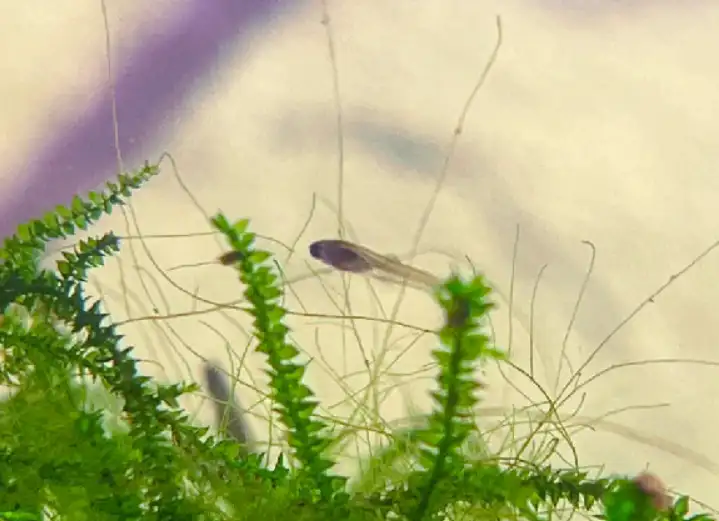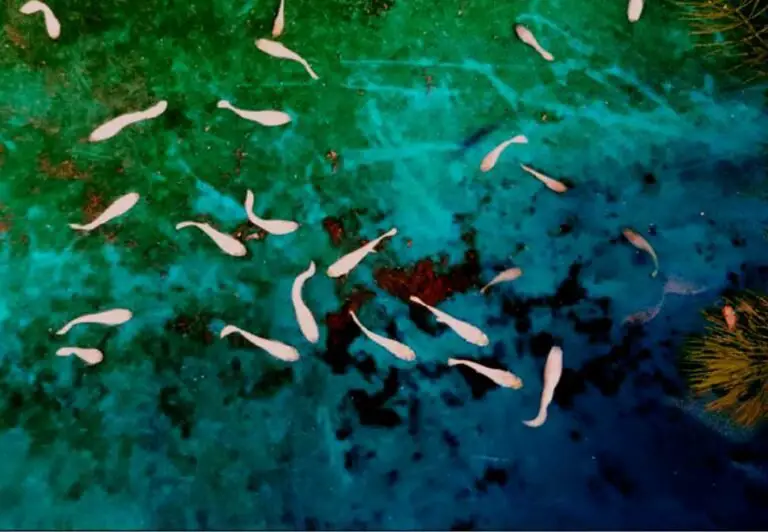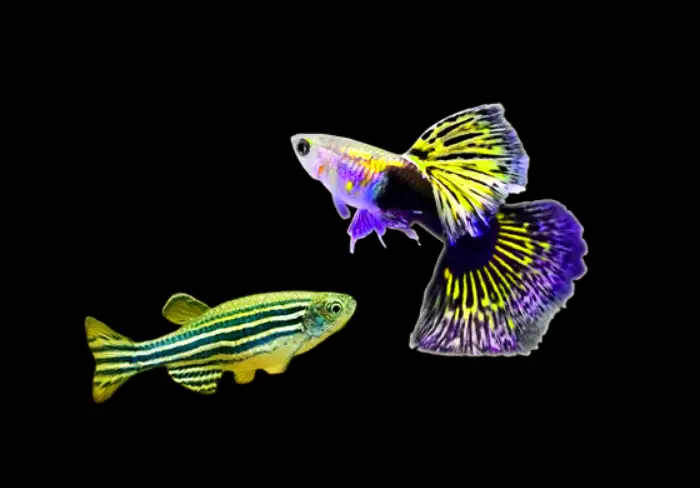15 Facts Of Guppy Fish – Lifespan, Temperature, Feeding, And Hidden Facts
Guppies are a famous fish breed among fish keepers, and they are easy to keep in the tank, feeding and breeding. They have unique colors, body features, and characteristics. In this article, you can find 15 facts about Guppy fish, which helps to increase your knowledge of guppies.
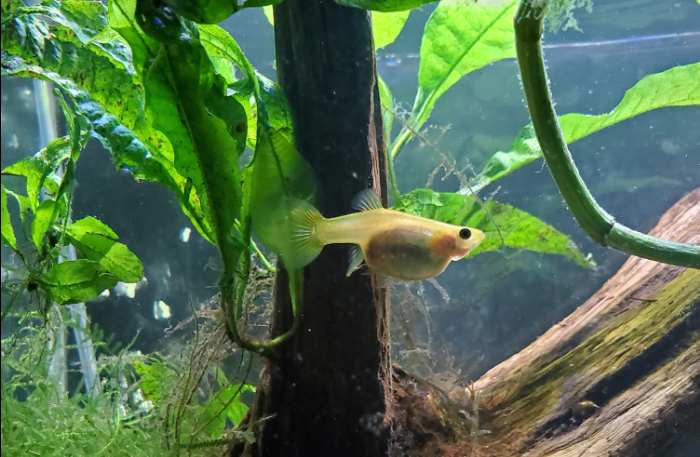
Table of Contents
- Guppy Fish Size
- Guppy Fish Lifespan
- Guppy Fish Tank And Requirements
- Guppy Fish Sexing
- Guppy Fish Temperature Requirements
- Guppy Fish Feeding
- Guppy Fish Compatibility
- Guppy Fish Illnesses
- Encouraging Guppy Fish Breeding
- Guppy Fish Sleep Patterns
- Sudden Death in Guppy Fish
- Disappearance of Guppy Fish
- Tank Size for Guppy Fish
- Creating a Natural Habitat for Guppy Fish
- Maintaining Water Quality for Guppy Fish
- Conclusions
Guppy Fish Size
The standard Guppy fish size is a small, peaceful tropical fish that grows to an average adult length of 3-4 inches (7.5-10 cm) in captivity. Guppies can reach up to 5 inches (12.5 cm) long in the wild.
These live-bearing fish have an oval-shaped, laterally compressed body well-suited for life in the “shallow waters of streams, ponds, and brackish coastal waters” of Central America. Their maximum reported weight is just 0.25 ounces (7 grams).
The modest mature size of 2-4 inches makes Guppies ideal for housing in 10-20 gallon aquariums with other small, non-aggressive fish species and invertebrates. With an adult length of less than 4 inches, Guppies can comfortably swim and school in compact home aquariums. Their small footprint makes them suitable for nano tanks and desktop aquariums as small as 5 gallons.
Overall, the petite size, peaceful temperament, and adaptability of the Guppy make it one of the most popular fish for small and community aquariums. Their manageable mature length and weight allow aquarists to comfortably keep these lively fish even in relatively confined aquarium environments. Guppy’s fish size can be essential for a guppy’s lifespan.
Guppy Fish Lifespan
The average lifespan of the Guppy fish is 3-5 years when kept in a suitable aquarium environment. With optimal “water quality, diet, tank conditions, and care,” Guppies can survive up to 5 years and occasionally live as long as 6-7 years.
Guppies generally have a shorter lifespan of 2-3 years in the wild. Natural predators, irregular nutrition, and inconsistent water conditions diminish their longevity.
Several key factors influence the lifespan of Guppies in home aquariums.
- Water Quality: Guppies require pristine water with a pH of 7.0-8.0, temperatures of 70-82°F (21-28°C), and low ammonia and nitrate levels under 20 ppm.
- Diet: A varied diet of high-quality flake foods, live foods, and vegetables helps Guppies thrive. Guppy should get fed 1-2 times per day in small portions.
- Tank Size: A minimum 10-gallon tank is recommended for a Guppy fish to have ample swimming space.
- Tank Mates: Peaceful tank mates like platies, swordtails, and corydoras avoid stress and conflict.
- Care: Weekly water changes of 25%, proper filtration, and close monitoring help prevent disease.
With clean water, a healthy diet, proper tank conditions, and attentive care, the common Guppy fish can achieve a long natural lifespan of 5+ years in home aquariums. Their longevity reflects their overall health and welfare. The size of the tank directly affects the lifespan of Guppy.
Guppy Fish Tank And Requirements
Guppy fish tank size is a significant factor in keeping them healthy and active, and providing the following aquarium conditions is recommended.
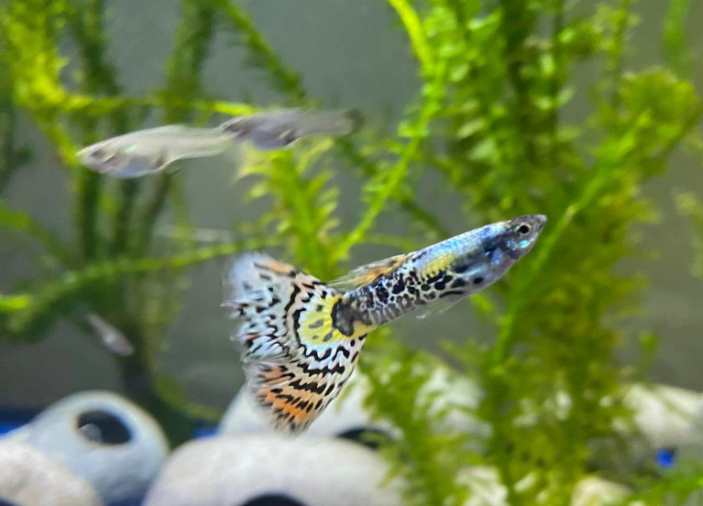
- Tank Size: A minimum 10-gallon tank is suggested for 1-2 Guppies. Larger tanks are better to accommodate more fish. A general rule is 1 Guppy per 2-3 gallons of water.
- Group Size: Guppies are social and prefer to be kept in groups of 3-6 fish. Groups help reduce aggression and stress.
- Water Volume: Allow at least 20 gallons for a group of 4-6 Guppies to swim comfortably and school together.
- Tank Shape: A rectangular tank is ideal, providing more horizontal swimming space than tall tanks.
- Water Conditions: Guppies thrive in slightly hard and alkaline water with a pH of 7.0-8.0 and a temperature of 70-82°F (21-28°C).
- Filtration: Efficient filtration helps maintain low ammonia and nitrate levels under 20 ppm.
- Decor: Natural decor like rocks, driftwood, and live plants provide hiding spots and enrich the habitat.
By following these aquarium guidelines, Guppy fish can thrive in home tanks. Adequate space, swimming area, and water quality are essential to their health and natural schooling behaviors. Please avoid overcrowding.
Guppy Fish Sexing
Determining the gender of Guppy fish comes down to observing critical physical and behavioral differences between males and females.
- Size: Females grow significantly larger than males, reaching 4-5 inches (10-12 cm) vs 2-3 inches (5-7.5 cm) for males.
- Coloration: Males display more vibrant colors and elaborate fins. Females are drabber with more muted gray, brown, or green hues.
- Body Shape: Females have a rounder, fuller body for bearing young. Males have a slimmer, torpedo-shaped body.
- Gonopodium: Male fish use their gonopodium, a rod-shaped anal fin, to fertilize eggs internally. It is absent in females.
- Dorsal Fin: The dorsal fin is larger and more pointed in males than females.
- Behavior: Males are territorial, chasing each other aggressively. Females shoal together peacefully.
- Breeding: During mating, the male circles and nudges the female, then inserts his gonopodium to fertilize the eggs internally.
By 8-12 weeks of age, these prominent physical and behavioral differences allow Guppy fish to be accurately sexed. The gonopodium and larger female size make gender identification easy for aquarists.
Guppy Fish Temperature Requirements
Guppy fish require a temperature below 35°C. As tropical fish native to warm environments, Guppy fish require stable, warm water temperatures within an ideal range of 70-82°F (21-28°C) to remain healthy and active.
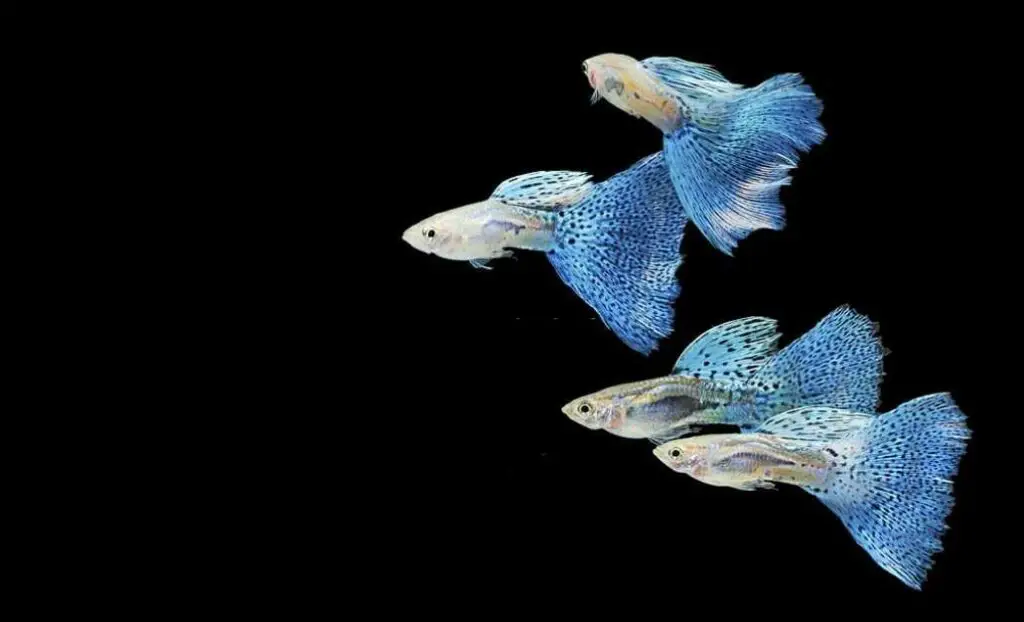
Guppies prefer water temperatures on the higher end of this range, around 78-80°F (25-27°C). It would be best to avoid temperatures that fall below 70°F or fluctuate wildly.
Sudden temperature drops can shock Guppies and lead to stress, lethargy, loss of appetite, and increased susceptibility to disease. Prolonged cold temperatures below 65°F can be fatal.
To maintain water temperature, every Guppy aquarium needs,
- Submersible Aquarium Heater: A 50-100 watt heater correctly sized for the tank volume helps maintain a stable temperature.
- Thermometer: This allows close monitoring to ensure the temperature stays within the ideal 70-82°F range.
- Location: Position the tank away from “drafty windows, air vents, and air conditioners” that may impact the water temperature.
Proper aquarium equipment provides consistent tropical temperatures so Guppy fish remain active, feed eagerly, and exhibit natural behaviors. Careful monitoring and maintaining ideal warm water conditions is fundamental to their health and well-being.
Feeding high-protein food is another essential factor for guppy fish.
Guppy Fish Feeding
Guppy fish feed needs to include high-protein fish feed. Guppy fish are omnivorous and require a varied diet to remain healthy.
- High-Quality Flake Food: This provides balanced nutrition. Offer a tropical flake once or twice daily.
- Live Foods: Feed microworms, brine shrimp, or mosquito larvae 2-3 times weekly. This mimics their natural insect diet.
- Vegetables: Blanched spinach, zucchini, cucumber, or peas 2-3 times per week provide fiber.
- Frozen Foods: Variety is key. Cyclops, daphnia, and mysis shrimp make nutritious treats.
- Pellets: Sinking shrimp or algae pellets supplement flake foods.
- Feed Amount: Only feed enough that fish can consume within 2-3 minutes, 1-2 times daily. Remove any excess.
- Supplements: Adding vitamin drops or flakes boosts nutrition once per week.
By offering a diverse diet, Guppy fish intake all the proteins, vitamins, and nutrients essential for good coloration, proper growth, and overall health. Aim for variety, balance, and moderation when feeding Guppies.
Guppy Fish Compatibility
Guppy fish are peaceful, social fish that thrive in community aquariums when provided with suitable tank mates. Here are some compatibility guidelines.
- Peaceful Species: Guppies coexist well with tetras, rasboras, danios, corydoras catfish, platies, swords, and dwarf cichlids. These make ideal tank mates.
- Same Size: Choose tank mates that aren’t 4 inches long since larger aggressive fish may bully or prey on Guppies.
- Schooling Fish: Schooling species like tetras bring out Guppies’ natural schooling instincts. They feel secure and interact positively.
- Avoid Aggression: Cichlids, Oscars, Jack Dempsey, and other large, aggressive species should not be housed with Guppies due to the stress and danger they impose.
- Plants & Hiding Spots: Plenty of plants, rocks, and driftwood provide cover and visual barriers, reducing aggression from territorial fish.
- Group Stocking: Keep Guppies in groups of 3-6 individuals to minimize aggression, distribute dominance, and allow natural shoaling.
With the proper tank mates and setup, Guppy fish thrive in peaceful community aquariums where their gentle temperament is respected.
Guppy Fish Illnesses
Guppy fish diseases are treatable. Guppy fish are prone to several infectious diseases in aquarium environments, especially under stressful conditions or poor water quality. Some common illnesses include.
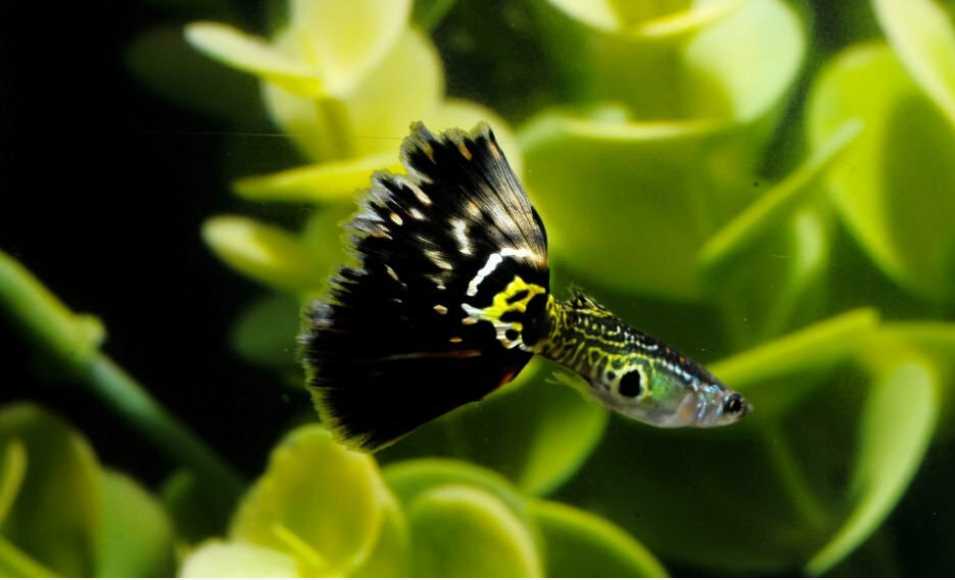
- Ich (Ick): The ciliate parasite Ichthyophthirius multifiliis causes ich. Small white spots resembling salt grains clustered on skin, fins, and gills appear.
- Fin Rot: Bacterial infection that causes “fraying, erosion, and disintegration of fins.” It usually starts at the fin edges.
- Fungal Infections: Fungi such as Saprolegnia will cause cotton-like growths on the skin and fins in immunocompromised fish.
- Dropsy: Fluid retention in the abdominal cavity gives a “pinecone” appearance. Kidney failure, parasites, or infections can cause it.
- Swim Bladder Disorder: Poor nutrition often causes impaired swim bladder function, leading to balance and buoyancy problems.
- Velvet Disease: Skin irritation and yellow powder-like coating caused by the dinoflagellate parasite Oodinium pillularis.
Prevention involves maintaining excellent water quality, reducing stress, feeding a nutritious diet, and quarantining new fish. With prompt treatment, most Guppy diseases can be cured if caught early.
Healthy and disease-free Guppy are suitable for the breeding process.
Encouraging Guppy Fish Breeding
Guppy fish breeding is not complex compared to other livebearer breeds. When you select guppy fish for breeding, you need to choose healthy, active, and complete body features for the breeding process.
- Gender Groups: Keep 1 male for every 2-3 females to allow the male to pursue multiple partners while reducing stress on females.
- Water Temperature: Maintain water between 78-82°F to trigger spawning behavior. Cooler temps inhibit breeding.
- Water Changes: Frequent partial water changes with treated water keep parameters ideal and stimulate spawning.
- Live Foods: Feed a varied diet with live foods like brine shrimp, black worms, and tubifex worms to strengthen fish and promote breeding conditions.
- Plants: Floating and dense stem plants provide safety for hiding and laying fry. Java moss is excellent.
- Fry Tank: Set up a separate 10-20 gallon tank to transfer pregnant females so they can give birth safely away from other fish.
- Tank Size: Breeding is more likely in larger tanks of at least 30-40 gallons, which reduces territorial disputes.
With some simple tank adjustments and care techniques, Guppy fish can successfully breed multiple times yearly in home aquarium settings.
Guppy Fish Sleep Patterns
Guppy fish do not sleep like humans but require periods of rest and inactivity at regular intervals. Here are some critical facts about Guppy’s sleep cycles.
- Guppies are diurnal, most active during daylight hours. At night, they enter a state of lowered alertness and metabolism.
- Guppy rest phase usually lasts 6-10 hours overnight. During this time, Guppies float motionlessly or slowly drift along the bottom.
- While resting, Guppy’s gill movement slows, and their coloration darkens or loses vibrancy.
- Guppies need a consistent photoperiod with 10-12 hours of daylight and 10-12 hours of darkness daily. Irregular light cycles disrupt their bio-rhythms.
- Floating plants, rock overhangs, and other shaded areas provide refuge during Guppy’s inactive nocturnal period.
- Disrupting Guppy’s rest by leaving lights on or exposing them to noise and vibrations during their sleep phase can lead to stress.
Though not actual sleep, providing Guppies a regular daily cycle with sufficient nocturnal rest allows their bodies to recuperate, supporting long-term health.
Sudden Death in Guppy Fish
Sudden death in guppy fish does not often occur. Sudden, unexplained mortality in apparently healthy Guppy fish is usually due to these factors.
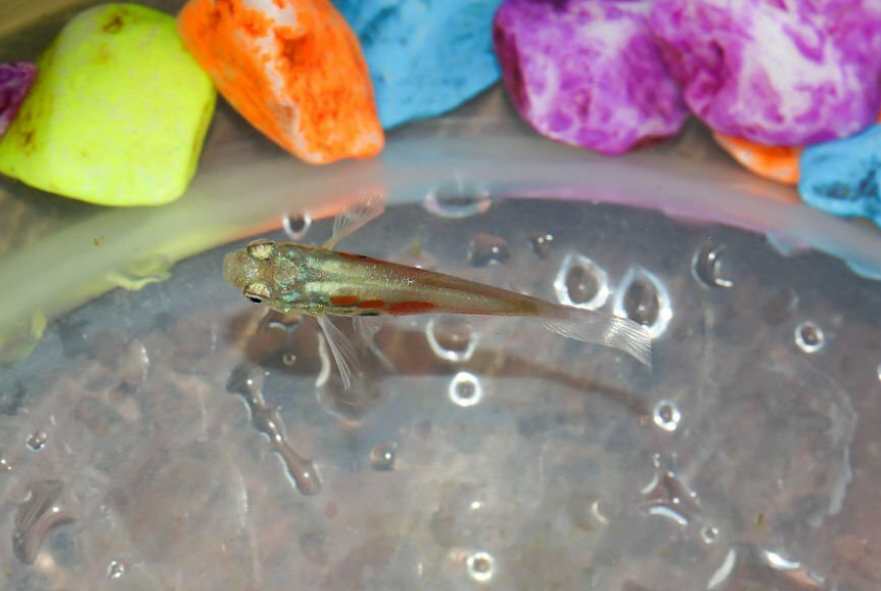
- Water Quality: toxins from high ammonia, nitrites, or nitrates can lead to sudden death. Low oxygen, improper pH, or temperature fluctuation can harm guppy fish life.
- Disease: undiagnosed infections like “ich, cholera, tuberculosis, or parasitic” infestations
- Stress: aggression from tank mates, overcrowding, harassment during breeding, and poor handling can increase guppy fish stress, and it can be a reason for sudden death in guppy fish.
- Starvation: inadequate diet lacking proper nutrition.
- Age: Guppies over 3 years old may die suddenly from organ failure due to old age.
- Toxins: gas bubble disease from supersaturated water, medications, or chemicals
- Shock: abrupt fluctuations in water conditions like pH, temperature, and hardness which disorient fish
- Genetic Issues: inbreeding depression leads to compromised immune response
- Predation: larger tank occupants may “attack, kill, and consume” Guppy fish overnight
Careful monitoring, ideal water parameters, a nutritious diet, and a low-stress environment can help avoid sudden losses. Quarantining new fish and acting quickly at signs of disease also reduces risk.
Disappearance of Guppy Fish
Disappearance of guppy fish may have several factors. If the previously visible guppy fish suddenly disappear, the following factors may explain their absence.
- Illness: Sickness often causes Guppies to hide. Check for signs like clamped fins, loss of color, or labored breathing.
- Stress: Aggression from tank mates, overcrowding, or water issues can trigger Guppies to hide in decor.
- Insufficient Feeding: Hunger may make Guppies less bold and more secretive as they search for food.
- Predation: Larger predatory fish may prey on small Guppies, especially at night when not easily visible.
- Old Age: Elderly Guppies tend to be less active, lying in the bottom and spending more time sheltered among plants or decor.
- Insufficient Lighting: Low light levels can elicit hiding and reclusive behavior in Guppies.
- Tank Size: If the aquarium is too small, Guppies may disappear from immediate view but still be present.
- New Environment: Newly added Guppies may go into hiding initially as they adjust to a new tank.
Closely observing Guppy’s behavior, inspecting decor, reducing stressors, and testing water parameters can help reveal the underlying cause if Guppies start vanishing.
Tank Size for Guppy Fish
Guppy fish tank size plays a significant role, and tank size directly connects with guppy fish growth, health, and lifespan.
- Single Guppy: A minimum 10-gallon tank is suitable for one Guppy fish, providing adequate swimming space.
- Pair of Guppies: A 20-gallon tank can comfortably house a pair of Guppies, allowing each about 10 gallons.
- Small Group: For a group of 4-6 Guppies, aim for a 30-40 gallon tank, allocating 2-3 gallons per fish.
- Large Group: A 50-60 gallon tank can fit 8-10 Guppies while avoiding overcrowding.
- Breeding: Use a 20-30 gallon breeding tank for 1 male and 2-3 females to allow room for fry.
- Larger Tanks: Large-sized tanks give their active nature and make it better for Guppies to thrive. Aim for 3-5 gallons per fish.
- Tank Shape: Prioritize horizontal swimming space, so standard 20-30 gallon tanks are better than tall hexagon tanks.
Providing Guppy fish with adequate tank space reduces aggression, improves health, and allows them to exhibit natural schooling and swimming behaviors. Follow the 2-3 gallon per fish rule.
www.tinyfishtank.com
Creating a Natural Habitat for Guppy Fish
Guppies like to live in wild natural habitat, and natural habitat helps to increase their lifespan.
- Plants: Include hardy plants like Java fern, Anubias, Vallisneria, and Amazon sword plants to recreate their densely vegetated native waters.
- Substrate: A fine sand or smooth gravel bottom mimics the muddy substrates of their habitat. Choose natural tones.
- Water: Use slightly hard water with a pH of 7.0-8.0, temperatures of 78-82°F, and low salinity, matching their natural freshwater environment.
- Decor: Add smooth rocks, bogwood, and floating plants to provide shaded hiding spots and territory markers.
- Open Space: Leave ample swimming areas for Guppy schools to move freely.
- Water Currents: An air-powered sponge filter or power head creates a gentle current reminiscent of streams.
- Lighting: Set a 12-hour photoperiod with full spectrum or plant growth LEDs to mimic tropical day-night cycles.
Recreating natural environmental elements reduces stress on Guppy fish, allowing “natural foraging, schooling, and breeding behaviors” to emerge.
Maintaining Water Quality for Guppy Fish
Maintaining water quality is compulsory for a guppy fish. When you have a 10-gallon water fish tank or a below-size tank, you should do adequate water changes at the correct times.
- Weekly Water Changes: Change 25% of water weekly to replenish minerals and reduce nitrate accumulation using a gravel vacuum.
- Test Water: Use liquid test kits weekly to monitor ammonia, nitrites, nitrates, pH, and hardness to ensure levels are within recommended ranges.
- Powerful Filter: An external canister filter sized for the tank provides robust mechanical, chemical, and biological filtration to remove waste.
- Conditioner: Use a water conditioner when changing water to remove chlorine/chloramines and detoxify heavy metals present in tap water.
- Algae Control: Limit light duration to 8 hours daily, remove excess food, and clean glass to minimize algae growth, which can degrade water quality.
- Stock Levels: Avoid overcrowding by sticking to the rule of 2-3 gallons per Guppy to keep waste in check.
- Quarantine: Quarantine new fish for 2-4 weeks to prevent introducing pathogens.
Closely monitoring and maintaining all water parameters is critical to providing Guppy fish with a healthy, life-promoting environment where they can thrive.
www.tinyfishtank.com
Conclusions
Guppy fish are a small tropical species ideal for community aquariums due to their peaceful temperament and modest adult size of 2-4 inches. With clean water, a stress-free environment, and proper nutrition, Guppy fish can live 3-5 years on average. Adequate tank space is crucial, so follow the general rule of 1 Guppy per 2-3 gallons of water. Overcrowding causes aggression and illness.
Males have brighter colors, slimmer bodies, and gonopodiums. Females are larger and plainer. Identifying gender prevents overpopulation. Maintain the water temperature between 70-82°F. Feed a varied diet of quality flakes, vegetables, and occasional live foods for optimal health. Guppy fish make lively, rewarding additions to community freshwater aquariums by meeting their care requirements.

